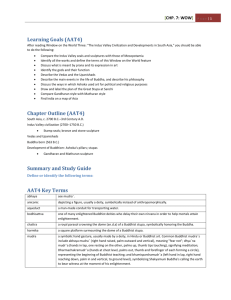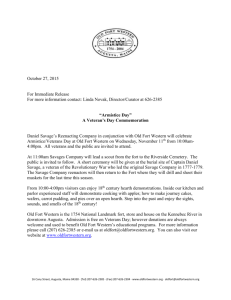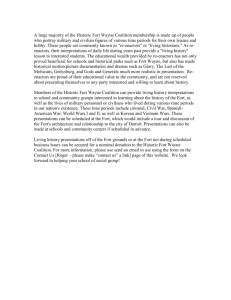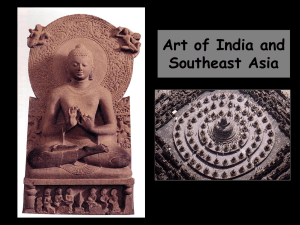Heritage sites in capital region
advertisement
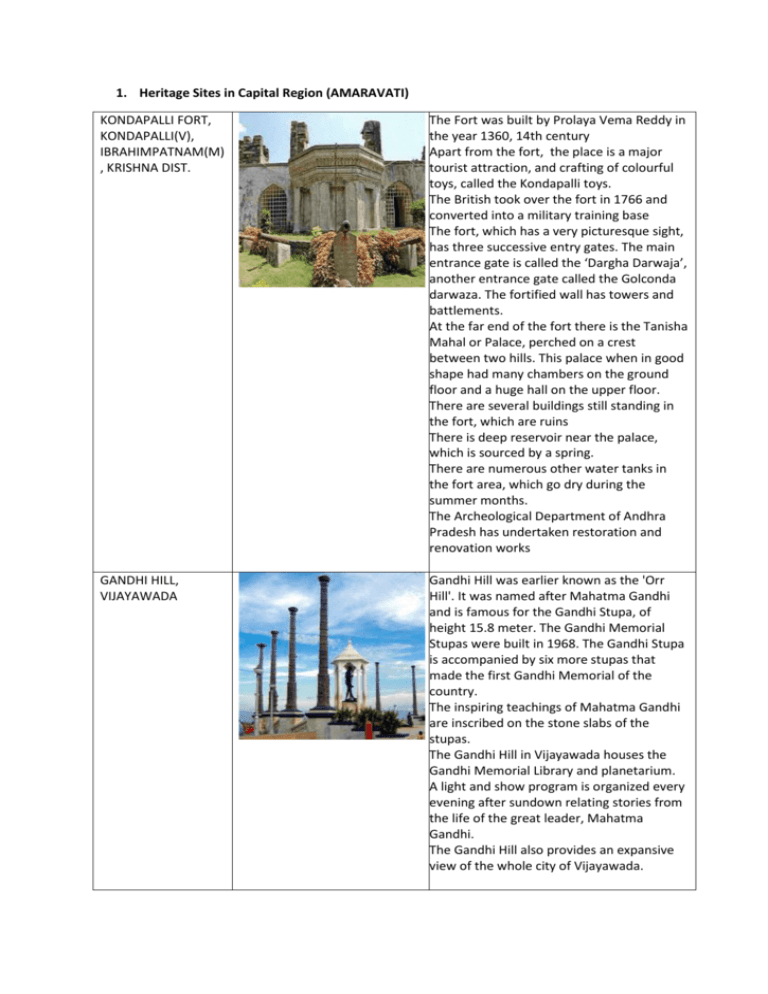
1. Heritage Sites in Capital Region (AMARAVATI) KONDAPALLI FORT, KONDAPALLI(V), IBRAHIMPATNAM(M) , KRISHNA DIST. The Fort was built by Prolaya Vema Reddy in the year 1360, 14th century Apart from the fort, the place is a major tourist attraction, and crafting of colourful toys, called the Kondapalli toys. The British took over the fort in 1766 and converted into a military training base The fort, which has a very picturesque sight, has three successive entry gates. The main entrance gate is called the ‘Dargha Darwaja’, another entrance gate called the Golconda darwaza. The fortified wall has towers and battlements. At the far end of the fort there is the Tanisha Mahal or Palace, perched on a crest between two hills. This palace when in good shape had many chambers on the ground floor and a huge hall on the upper floor. There are several buildings still standing in the fort, which are ruins There is deep reservoir near the palace, which is sourced by a spring. There are numerous other water tanks in the fort area, which go dry during the summer months. The Archeological Department of Andhra Pradesh has undertaken restoration and renovation works GANDHI HILL, VIJAYAWADA Gandhi Hill was earlier known as the 'Orr Hill'. It was named after Mahatma Gandhi and is famous for the Gandhi Stupa, of height 15.8 meter. The Gandhi Memorial Stupas were built in 1968. The Gandhi Stupa is accompanied by six more stupas that made the first Gandhi Memorial of the country. The inspiring teachings of Mahatma Gandhi are inscribed on the stone slabs of the stupas. The Gandhi Hill in Vijayawada houses the Gandhi Memorial Library and planetarium. A light and show program is organized every evening after sundown relating stories from the life of the great leader, Mahatma Gandhi. The Gandhi Hill also provides an expansive view of the whole city of Vijayawada. MOGALARAZAPURA M CAVES, VIJAYAWADA PRAKSAM BARRAGE There are total 5 caves on the hill These are excavated on the southern face of the hillock The cave starts with a triple passage formed by two massive pillars in the center. The cornice running over them carries dwarfish ganas with raised up hands. On the backside there are representation of garland bearers and a row of geese. At the bottom of the pillar towards left there is a representation of a Purnaghata. With the three shrines in the back wall, the sanctuary may be said to have been dedicated to Trimurti. The excavation is attributed to the Visnukundin kings who ruled Vengi between 4th and 5th century AD Prakasam Barrage is 1223.5 m long and was completed in the year 1957. The barrage was started in 1852 and completed in 1855. Later the State Government constructed a new regulator cum-round bridge that was named after Sri Tanguturi Prakasam, the first Chief Minister of Andhra Pradesh. Completed in 1957 it helps irrigating over 12 lakh (1.2 Million) acres of land. One of the first major irrigation projects of South India. water level up to a minimum of 17.42 metres has to be maintained to facilitate the passage of water into the cooling canal which carries water to the thermal Power plant at Ibrahimpatnam, with a capacity of 1,260 MWs (six units of 210 MWs each). The barrage serves also as a road bridge and spans over a panoramic lake. The three canals associated with the barrage, run through the city of Vijayawada criss crossing it and giving it a Venetian appearance. The barrage provides gorgeous view with the shimmering lake. it is the largest in the asian continent Four pillars in the ruined mandapam in Jammidoddi, Vijayawada This four-pillared mandapa, originally pertaining to Mallesvarasvami temple compound at the foot of the Indrakila hill, is now reconstructed near Akkanna cave. This mandapa has exquisitely carved pillars with corbels and lintels surmounted. All round the plinth of the mandapa on its exterior face there are beautiful sculptures depicting stories from the Puranas. The representations of mithunas in between Puranic scenes are noteworthy. These four artistic pillars of the mandapa contain 43 valuable records, datable to 12th13 centuries AD. One of these refers to a grant by a brotherin-law of the famous Kakatiya king Ganapathi Deva. INSCRIBED PILLAR AND SLAB IN MALLESVARASVAMI TEMPLE, VIJAYAWADA The temple of Mallesvara, situated at the foot of the Indrakila hill at Vijayawada. There are 10 pillars in this temple, contain a number of inscriptions in Telugu language and script which supply us some interesting accounts of the temple and the endowments made to it, by the rulers of this locality from 9th to 16th centuries. Of these the oldest and most important are the inscriptions of the Eastern Chalukyan kings Yudhamalla I (circa A.D. 890) and his grandson Yuddhamalla II. These pillars contains so many inscriptions ranging in date from A.D. 890 to A.D. 1515 Which denotes various contributions/ endowments by various rulers like Gonturu Nagadeva who describes himself as a Pallava chief and Lord of Kanchipura, Koppula chief Proli Nayudu, Bayapadeva Maharajulu of Peda Vegi, Siramaya, a dancing girl, Srigiribhakta, Chola-Patra, Yuddhamalla, the Imperial Chola king Kulottunga Chola, and Krishnadevaraya of Vijayanagara. ON A MUTILATED SLAB DUG UP IN THE COURTYARD OF THE TEMPLE: This inscription on a mutilated slab dug up in the courtyard of the temple belongs to the reign of Palla-Keta-Bhupala and records an endowment by him. On a stone formerly built into the roof of the Vignesvara shrine, now in the store-room. This stone contains five inscriptions of which four bear dates, Saka 1135, 1157, 1191 and 1209. The first of the above inscriptions records a donation by Kandradi Bhima Raja KIRATARJUNA PILLAR ON THE INDRAKILA HILL, VIJAYAWADA This pillar once on the top of the Indrakila hill is now erected near the Akanna Cave. This red stone pillar contains an inscription datable to 9th century AD, which is engraved on its two sides. The two other sides of the pillar as also portions of the written faces contain sculptured scenes which illustrate story of Kiratarjuniya of the Mahabharata in which Arjuna is said to have fought with Siva disguised as a hunter and after a severe hand-to-hand contest Arjuna obtained the weapon Pasupatha from Lord Siva. The interesting inscription has to be read from bottom to top. It registers the setting up of the pillar by a certain Trikotiboyi of Pechche (va) da. It begins with a Sanskrit verse, which consists of a string of synonyms of Arjuna. Then follow a long prose passage in Sanskrit, an imprecatory verse and the name of the writer Vijayacharya in archaic Telugu characters of about 9th century AD. AKKANNA MADANNA CAVES ON INDRAKILA HILL, VIJAYAWADA This caves consists of 1) a two celled shrine facing the East and 2) a triple celled temple with a pillared hall in front and Linga in the middle Cell. These caves and halls dedicated to Hindu Gods and Goddesses, belonging to Vishnukundins and Eastern Chalukyas that is 5th to 8th centuries AD like their Buddhist counterparts. An extensively cut-out triple shrines, known locally as Akanna-Madanna caves or mandapas, deserve specific mention. It is of the usual ground plan with a triple rear cells and a common pillared verandah in front. There is absence of ornamental moulding or carvings in these three shrines, but the pillars are entirely octagonal in section. Besides the above lower cave shrines, there is yet another cave temple unit towards north on the same hill, in somewhat higher levels of the hill. This cave temple seems to be dedicated to the trinity- Brahma, Vishnu and Siva. VICTORIA JUBLEE MUSEUM, VIJAYAWADA This is an archaeological museum located on Bander Road of Vijayawada. The museum is maintained by the Archaeological department and has large collection of sculptures, paintings and artifacts of Buddhist & Hindu relics, with some of them as old as 2nd and 3rd Centuries. The structure of building is an IndoEuropean style of architectural and is more than a hundred years old structure. The museum was created as part of the celebrations of the Golden Jubilee of Queen Victoria in 1887. Sri Pingali Venkayya presented a tri-colour flag to Mahatma Gandhi at this location in 1921. A standing Buddha of white limestone of Alluru(3rd–4th century), Lord Shiva and Goddess Durga slaying the buffalo demon Mahishasura (2nd century) can also found here. The museum has historical galleries, stone cut writings, coins, swords, body armour, shields, arms, ornamentation, etc., used by kings CHALLAPALLI FORT, CHALLAPALLI(V&M), KRISHNA DIST The fort was constructed in the early 18th century by the Raja of Challapalli, Srimanthu Raja Yaralagadda Ankineedu Prasad Bahadur. Challapalli became the capital for the Devarkota Estate and the town developed around the palace. It remains as a great example of Andhra architecture to this very day. The fort is still privately owned by the Royal family and attracts visitors for its beautiful architecture and well landscapes gardens. The majestic pillars adorning the front of the fort can be awe-inspiring. From third floor of the fort, there is an unobstructed view of the Maharani’s Anthapuram, which is located adjacent to the fort. BUDDHIST STUPA & MUSEUM, GHANTASALA (V&M), KRISHNA DIST. Ghantasala is at 11 km east of river Krishna and is around 60 km away from Vijayawada. It is a rare and reputed canter for Buddhist sculptures. A Buddhist museum is an attraction here Alexander Rea excavated the stupa at Ghantasala, which had a circumference of 112 feet and a height of 23 feet. Ghantasala was once a flourishing town of Indo-Roman trade as well as an important religious centre. The Buddhist relics and the Hindu structures at the place reveal its past glory. Carved limestone columns belonging to pillared halls associated with Buddhist monastic establishments (2-3rd centuries BC) have been discovered. The ruined Maha Chaitya or stupa that was excavated here is of a unique design. A cube of solid bricks is set in the centre, inscribed with 12 constellations of the zodiac.[2] The chaityas had a texture and size unique to the Satavahana times and had separate dwelling places for Buddhist monks in the complex. A three-dimensional limestone carved structure, embellished on the dome portion of the stupa had two garland bearers, a dhamma chakra and a miniature stupa on a throne in the middle. Objects such as a four-by-three-feet 'Purna Kalasa' containing lotus flowers, indicating the birth of Gautama Buddha were also discovered. KUCHIPUDI NATYA KALA KSHETRAM, KUCHIPUDI(V),KUCHI PUDI(M), KRISHNA DIST. Siddhendra Yogi kala Kshetram, one of the eight Schools of Potti Sreeramulu Telugu University, is situated in Kuchipudi The Kuchipudi Dance was evolved by Siddhendra Yogi, dating back to 15th century. This architect of Kuchipudi Dance initiated the local boys of Kuchipudi Village, situated in KRISHNA District of Andhra Pradesh to learn and perform his brainchild Bhama Kalapam - an aesthetic, descriptive and dramatic dance expression referred as Prabandha Nartanam. The Nawab of Golconda - Habul Hussan Qutub Tanisha, moved by the performance, gifted Kuchipudi Village and made it a cultural center to pursue the art with peace and harmony. MOUND CONTAINING BUDDHIST REMAINS AND ANCIENT VILLAGE SITE: GUDIVADA, KRSIHNA DISTRICT Nuzvid Fort Gate, NUZIVID, KRISHNA DISTRICT MYLAVARAM FORT, MYLAVARAM (V&M), KRISHNA DIST The place was in existence for over 2000 years and has been flourishing perpetually from time to time of the Satavahanas. As many of Buddhist sites, the mound containing a Buddhist stupa was also subjected to large-scale vandalism. This stupa most has been of the same size as that of Sanchi, the basal area being nearly 140 feet square. As no traces of stone exist in the neighbourhood it is supposed that the rail might have been made of brick or wood. Four stone receptacles each containing a crystal reliquary was also found from this stupa It is considered to be one among the seven Buddhist Stupas in the area Nuzvid is a historical fortified town. It was founded by Meka Basavanna, the chieftain of Rani Rudrama Devi/Pratapa Rudra Deva of Warangal Kakatiya dynasty in 1321 AD. After the second attack of Delhi ruler, Mohammad bin Tughlak to Kakatiya ruler of Pratapa Rudra, he was defeated and caught by Tughlak. At that moment the chieftains were separated and migrated to different places. Some went to Bobbili. Some established themselves at Nuzvid. At that period they cultivated the nuvvulu (Seasom) Crops. The place was first named as nuchela veedu, gradually changing to nujelaveedu and after British rule to Nuzvid. The first English-Telugu dictionary was prepared by Sankaranarayana with the financial help of Nuzvid Rajahs Mylavaram has a rich history of Zamindari ancestry which has contributed immensely for rural upliftment. Shri. S.V. Sudhakara Rao, Chairman & Founder Family member of Sri Venkateswara Swamy vari Devasthanam, Dwaraka Tirumala, W.G. District; a scion of the erstwhile Mylavaram Rajas. Mylavaram is famous for its rich culture and heritage in the pre-independence days. Zamindars of mylavaram are lovers of art. Ancient site and remains comprised in survey plot No. 37, Munagcherla(V), Nandigama(M), Krishna Dist.. Ancient site with the mound marking the Buddhist Stupas, ALLURU, VEERULAPADU(M), KRISHNA DIST. Till today the fort of Mylavaram exists in the heart of the town. The current Scion, Shri. S.V. Sudhakara Rao still resides in the very same Fort along with his 2 sons & their families The site was in continues occupation from 3rd to 16th century AD The surface collections and the trial digs at the site have yielded pottery of black, red, black and red wares of early historical period similar to those found at Nagarjunakonda and Amaravati sites. The other antiquities found at the site include beads of jasper and other semi precious stones of various shapes. The site is also containing Grey ware of medieval date and multicolour glass bangles of late medieval date. The village of Alluru, in district Krishna, is known for its Buddhist remains since 1926. The antiquity of the site goes back atleast to circa 2nd century A.D. The brick stupa unearthed here is wheelshaped on plan with a circular solid hut and spokes and tyre the hollowed sixteen cells filled with earth and bricks. The drum has a diameter of 23.37 meters and survived to a height of 2.65 mtr. It had four ayaka pillars at the cardinal projections of the drum each 4.46 in length and 61 cm wide. A stone pillared mandapa also existed. A limestone inscribed pillar with half-lotus medallions lies in the compound of the Siva temple. A standing life size Buddha of this place is now exhibited in the Victoria Jubilee Museum, Vijayawada. Three more smaller images from this place are in Site Museum, Amaravati. The other associated finds from the stupa include carved casing slabs and a stucco head etc. An inscription on the octogal pillar, dated in the 8th regnal year of Ehavula Chantamula, records the erection of Selakhambha by Venhusiri, resident of Halur UNDAVALLI CAVES , TADEPALLI(M), GUNTUR DISTRICT These caves were carved out of solid sandstone on a hillside in the 4th to 5th centuries A.D. There are several caves and the best known largest one has four stories with a huge recreated statue of Vishnu in a reclining posture, sculpted from a single block of granite inside the second floor. The main cave is one of the earliest examples of Gupta architecture, primarily primitive rock-cut monastery cells carved into the sandstone hills. Initially the caves were shaped as a Jain abode and the first floor abode still retains the Jain style; the vihara exhibits Jain monastics and includes tirthankara sculptures. The caves are associated with the Jain kings of 420 to 620 A.D. This first level of the cave is a carved vihara and includes Buddhist art work.. The site served as the Bhikkhu monastic complex during ancient period. The walls of the caves display sculptures carved by skilled craftsmen FOUR STOREYED ROCK CUT HINDU TEMPLE, UNDAVALLI , TADEPALLI(M), GUNTUR DISTRICT An impressive four storeyed rock-cut temple with façade facing east about 29 m long, 16m wide;’ Its construction was probably commenced in the 6th – 7th century AD. Ground floor is an unfinished low pillared hall with 8 pillars and 7 door openings on façade. First storey accommodates triple shrine (now empty) at back, each with pillared hall in front, originally dedicated to the Trinity (Trimurthi – Siva Vishnu and Brahma) and a small rock-cut attendant shrine on north. Second storey has a pillared rectangular shrine of Anantasayi (Vishnu reclining on serpent couch) on north and a lesser shrine on south. Top floor was intended for a triple shrine but unfinished. Some of the extant sculptural specimens, on stylistic grounds were attributed to the Chalukyan period. Arahaeological Museum, AMARAVATHI (V&M), GUNTUR DISTRICT The Museum consists of 3 galleries. In the key gallery selected examples of the art traditions of Amaravati like Lotus and Purnakumbha are displayed. The standing Buddha secured from Gummadidurru is datable to eight century AD. In second gallery contains the life size standing image of Buddha in super human form with marks of great man (Maha Purusha Lakshana), Triratna, animal rows and minor antiquities like coins and beads. The third gallery comprises a few sculptures of 2nd cent. BC including an Yakshi of Bharhut tradition, a stele with labeled panels, and a fragmentary pillar edict of Asoka. Images of Buddha from Alluru, Dharma Chakra from Lingaraja Palli, Bodhistvas, a dome slab depicting the jeweles of the Buddhist The couple in round in the central showcase is a masterpiece of Amaravati Art, with full of vigour and vitality, of the Satavahana period. The full size ornate bull (nandisvara) of the Satavahana period in round is an attractive piece of art picked up from the local Amaresvara temple. The garland and bearers of a copingstone, the images of Vajrayana period, and a Jaina Tirthankara of medieval times are quite interesting in this gallery. Ruined Buddhist stupa and other remains in Amaravati, Gunrur District Colonel Colin Mackenzie of the Trignometrical survey had discovered the remains of the stupa in 1797. The great stupa or Mahachaitya at Amaravati is considered to be one of the biggest stupas in Andhra Pradesh. It was erected during the mauryan rule (c. 3rd cent. B.C.) and was under constant patronage during subsequent dynasties and in prominence as late as 14th cent. A.D. The Chinese traveler Yuan Chwang and the Tibetan Historian Taranath glorified in their accounts the greatness of this ancient seat of Buddhism. The rich sculptural carvings of this sarirakastupa are a class of its own popularly known as 'Amaravati school of art'. The relic caskets found here are testimony to the sanctity and reverence attached to it. Most of the sculptures of this stupa have enriched some of the acclaimed museums in India, Britain and Germany. Rest of the sculptures are on display in the site museum. Inscribed rock to the west of Dharanikota, AMARAVATI(M), GUNUTUR DIST These Prakrit Inscriptions date back to Satavahana Period. These Inscriptions follow Amaravati School of Art. The stupa at Dharanikota was adorned wit limestone reliefs and free standing Buddha figures. The three Cubits long rail found here is the gift of Sidhathaya, the female pupil of Purva-Mahavina-Seliya. FORT IN RUINS, DHARANIKOTA, AMARAVATI(M), GUNTUR DISTRICT Black and Red ware of Megalithic fabric, A hearth with vent-holes, suggestive of its use by the users of latirite ridge were found. Excavations also showed structural activity in the shape of drains and soakpits , indicative of sanitary development of the settlement. Multi coloured glass and ceramic ware were found from these sites. Particularly important find ware coins of Satavahana period and an Inscribed Ivory seal showing the stupa with railings. Latest activity before final abandonment of the site showed Tiled platforms. BUDDHA KSHETRAM, VADDAMANU , TULLURU(M), GUNTUR DISTRICT The excavations at Vaddamanu have brought to light religious structures spread over a period of 500 years, starting from the Second Century BC. Phased structural activity is noticed on the terrace of the hill. Earliest activity at the site shows presence of a stupa. It also has a sixteen pillared hall, two wings of a Vihara, towards east and west. Stupas at Vaddamanu date back to Mouryan period and they are structurally different from stupas at Amaravati and Nagarjuna Konda. Another inscription in Brahmi characters is found near outer vihara. It possibly refers to village name of Salipura(town of rice) in olden times, as etymologically the present name Vaddamanu is the equivalent to ancient form Salipura. ARCHAEOLOGICAL SITES, GARIKAPADU, KROSURU(M), GUNTUR DISTRICT Mounts and Stupas excavated at Garikapadu date back to Neolithic to Early historical period. For the Stupa at Garikapadu, unconventional way of Solid flooring above the earth-packing at regular intervals was implemented. The flooring was made of concrete. Five coins which appears to be issues called Pagodas of Madras, which were originated during the time of king Ranga Raja were found. HILL FORT OF REDDY KINGDOM, KONDAVEEDU , YADLAPADU(M), GUNTUR DISTRICT Kondaveedu Fort is to be found at a distance of 25 km from Guntur. Kondaveedu fort was built by Anapotha Reddy in the 1250 A.D and later developed by Ana Venkata Reddy. Later it went under the rule of Gajapathis. Fort was considered impregnable with 24 bastions and spread across 30 hillocks. Located on a hilltop, this historical fort offers around 21 stupas. There are also many temples, residential structures and pillared halls. Recent archaeological excavations unearthed a 14th century inscription penned by Kavi Sarvabhauma Srinadha and an idol of Raja Rajeswari. The Presiding Diety of this place is Trikoteswara Swamy situated on the hillock and is one of the noted piligrim centres attracting thousands of visitors on Sivarathri day. BELLAMKONDA FORT (THE REDDYS AND VIJAYANAGARA KINGDOM), SATTENAPALLI(M), GUNTUR DISTRICT The fort consist of a single stone wall, connecting the elevated points of the hill and having bastions at the south-east and north-west angles, which terminate the two extremities of the principal front. In shape, the fort is roughly an equilateral triangle, enclosing an area of irregular elevation of about one-sixteenth of a square mile. There still remain some buildings of stone, the old magazine and storerooms. It is said to have been constructed by the Reddi kings of Kondavid. After their power had passed away in 1482 it fell into the hands of the Orissa kings, then Sultan of Golconda, followed by Viajayanagara kings and finally Muhammadans in 1578. EARLY HISTORIC SITE, MALLEPADU , TENALI(M), GUNTUR DISTRICT Mallepadu, with history dating back to the 5th century B.C, proved to be a treasure trove of pre-historic remnants and Buddhist relics Excavations at Mallepadu yielded prehistoric conical bowls, black and red pottery stands, lamp stands , jars and semi precious stones These remnants of red and black polished pottery are an indication of a flourishing civilisation during the early Satavahana period. Some of these pieces are also identified with other discoveries at Buddhist sites

